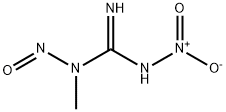CHEMICAL AND PHYSICAL PROPERTIES
| Physical Description | N-methyl-n'-nitro-n-nitrosoguanidine appears as a yellow powder. Melting point 244 °F. Decomposes above 212 °F. A suspected carcinogen. Extremely hazardous as a mutagen. Avoid skin contact and inhalation of of vapors. Usually stored frozen (below 32 °F) in polyethylene bottles that are tightly closed and contained in a metal can. May decomposed during prolonged storage and develop sufficient pressure in a closed container to explode. Keep away from heat, sparks, and open flame. |
|---|---|
| Color/Form | Crystals from methanol |
| Boiling Point | BP: 89-97 °C at 225 °C |
| Melting Point | 244 °F (decomposes) (NTP, 1992) |
| Solubility | Reacts with water violently (NTP, 1992) |
| Vapor Pressure | 0.00012 [mmHg] |
| Stability/Shelf Life | Stable under recommended storage conditions. |
| Decomposition | Hazardous decomposition products formed under fire conditions - Carbon oxides, nitrogen oxides (NOx). |
| Other Experimental Properties | At acid pH slowly releases nitrous acid to give N-methyl-N'-nitroguanidine; it is converted by concentrated aqueous alkali hydroxide to diazomethane; reactions with several nucleophiles are known, especially with amines |
| Chemical Classes | Nitrogen Compounds -> Other Nitrogen Compounds |
SAFETY INFORMATION
| Signal word | Danger |
|---|---|
| Pictogram(s) |
 Flame Flammables GHS02  Skull and Crossbones Acute Toxicity GHS06  Exclamation Mark Irritant GHS07  Health Hazard GHS08  Environment GHS09 |
| GHS Hazard Statements |
H228:Flammable solids H301:Acute toxicity,oral H315:Skin corrosion/irritation H319:Serious eye damage/eye irritation H332:Acute toxicity,inhalation H350:Carcinogenicity H411:Hazardous to the aquatic environment, long-term hazard |
| Precautionary Statement Codes |
P201:Obtain special instructions before use. P202:Do not handle until all safety precautions have been read and understood. P210:Keep away from heat/sparks/open flames/hot surfaces. — No smoking. P240:Ground/bond container and receiving equipment. P241:Use explosion-proof electrical/ventilating/lighting/…/equipment. P261:Avoid breathing dust/fume/gas/mist/vapours/spray. P264:Wash hands thoroughly after handling. P264:Wash skin thouroughly after handling. P270:Do not eat, drink or smoke when using this product. P271:Use only outdoors or in a well-ventilated area. P273:Avoid release to the environment. P280:Wear protective gloves/protective clothing/eye protection/face protection. P391:Collect spillage. Hazardous to the aquatic environment P308+P313:IF exposed or concerned: Get medical advice/attention. P405:Store locked up. P501:Dispose of contents/container to..… |
COMPUTED DESCRIPTORS
| Molecular Weight | 147.09 g/mol |
|---|---|
| XLogP3 | 0.1 |
| Hydrogen Bond Donor Count | 2 |
| Hydrogen Bond Acceptor Count | 5 |
| Rotatable Bond Count | 2 |
| Exact Mass | 147.03923904 g/mol |
| Monoisotopic Mass | 147.03923904 g/mol |
| Topological Polar Surface Area | 114 Ų |
| Heavy Atom Count | 10 |
| Formal Charge | 0 |
| Complexity | 161 |
| Isotope Atom Count | 0 |
| Defined Atom Stereocenter Count | 0 |
| Undefined Atom Stereocenter Count | 0 |
| Defined Bond Stereocenter Count | 0 |
| Undefined Bond Stereocenter Count | 0 |
| Covalently-Bonded Unit Count | 1 |
| Compound Is Canonicalized | Yes |
PRODUCT INTRODUCTION
description
N-methyl-n'-nitro-n-nitrosoguanidine appears as a yellow powder. Melting point 244 °F. Decomposes above 212 °F. A suspected carcinogen. Extremely hazardous as a mutagen. Avoid skin contact and inhalation of of vapors. Usually stored frozen (below 32 °F) in polyethylene bottles that are tightly closed and contained in a metal can. May decomposed during prolonged storage and develop sufficient pressure in a closed container to explode. Keep away from heat, sparks, and open flame.

